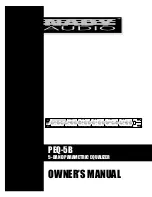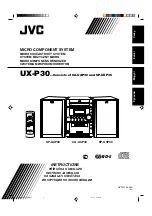
2. Use in Sound Reinforcement
In typical live sound applications, EQ's are used to increase
the overall volume or "punch" of the sound (while eliminating
feedback), enhance the natural "musicality" of the mix, and
improve the intelligibility of speech. Understanding that there
are always compromises that must be made, care must be
taken so that the overall effect of the equalization is an
improvement, not deterioration, of the overall sound.
Sometimes, hard decisions must be made between priorities
for achieving the desired result. For example, it may not be
possible to have a natural sound and acoustic power or
speech intelligibility at the same time.
Although pink noise or swept sine waves are often the best
way to identify problems of room acoustics and system defi-
ciencies (especially in the critical range of 2 to 4 KHz), the
ear can also be used with great effect, especially if care is
taken to train it to serve as a sound evaluation diagnostic
tool. Start by playing music or speech program material with-
out equalization, and add it slowly so you can gauge the
effects on the sound you can hear from the different settings.
Ultimately, there is no substitute for experience in utilizing the
PEQ-5B to its fullest potential.
Often, you will find that room acoustics problems must be
dealt with at the source, as they cannot be fixed as effectively
by using an equalizer. To check out room acoustics most accu-
rately, use either a pink noise or swept sine wave generator
and a real-time analyzer (RTAS) with a calibrated microphone
and verify that the measured frequency response, at various
points in the room, are all about the same. If they are not,
then you may need to make corrections to your setup, check
system and speaker phasing, etc., to minimize the variations
you are measuring. This can also be done with a trained ear
but requires very careful concentration and considerable ear
training for most effectiveness. Once you have made all the
improvements you can to your basic setup, you can fine tune
the system with the PEQ-5B.
(Note: Although equalizers are the most important acces-
sories in your audio system, and can often deliver amazing
results in improving the overall punch and sound quality of
your system, they cannot work miracles. Ultimately the rest of
your system and setup must also operate at top efficiency for
the PEQ-5B to be most effective.)
10
3. Inserting the PEQ-5B in the Signal Path
The PEQ-5B can be inserted in the signal path at different
points, depending on the setup and application of your sys-
tem. For example, it can be inserted in the line inserts of your
mixer, sub-group inserts, effects paths, or between signal
processors and mixer or power amps, and so on.
(Note: In the event of a power supply disconnection or failure,
a relay built into the PEQ-5B automatically silently bypasses
the unit. This relay also prevents bothersome "thumps" when
first turning on the unit.)
For use with more complex systems, such as complex sound
reinforcement applications with speakers located in varying
acoustic environments and utilizing delay line units for run-
time difference compensation, it is recommended that you
consult with experienced audio sound technicians or read
more extensive written material on this subject, as it is beyond
the scope of this manual to provide more than introductory
information on the use of the PEQ-5B.






























